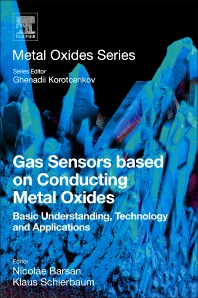Books in Materials chemistry
Books in Materials chemistry
- 1st Edition
- Volume 73
- February 19, 2019
- Rudi van Eldik + 1 more
- English
- Hardback9 7 8 0 1 2 8 1 5 7 2 8 2
- eBook9 7 8 0 1 2 8 1 5 7 2 9 9

Computational Chemistry
- 2nd Edition
- November 30, 2018
- Oleg D Neikov + 2 more
- English
- Hardback9 7 8 0 0 8 1 0 0 5 4 3 9
- eBook9 7 8 0 0 8 1 0 0 5 4 7 7

Handbook of Non-Ferrous Metal Powders
- 2nd Edition
- November 30, 2018
- Frederick E. Wang
- English
- Paperback9 7 8 0 4 4 4 6 4 2 0 1 1
- eBook9 7 8 0 4 4 4 6 4 2 0 2 8

Bonding Theory for Metals and Alloys
- 1st Edition
- November 23, 2018
- Munenori Numata + 2 more
- English
- Paperback9 7 8 0 1 2 8 1 2 1 2 6 9
- eBook9 7 8 0 1 2 8 1 2 1 2 7 6

Kinetic Control in Synthesis and Self-Assembly
- 1st Edition
- October 17, 2018
- Nicolae Barsan + 1 more
- English
- Paperback9 7 8 0 1 2 8 1 1 2 2 4 3
- eBook9 7 8 0 1 2 8 1 1 2 2 5 0

Gas Sensors Based on Conducting Metal Oxides
- 1st Edition
- September 19, 2018
- I. M. Mahbubul
- English
- Paperback9 7 8 0 1 2 8 1 3 2 4 5 6
- eBook9 7 8 0 1 2 8 1 3 2 9 9 9

Preparation, Characterization, Properties, and Application of Nanofluid
- 1st Edition
- September 17, 2018
- Hee Young Kim + 1 more
- English
- Hardback9 7 8 0 1 2 8 0 9 4 0 1 3
- eBook9 7 8 0 1 2 8 0 9 3 8 4 9

Ni-free Ti-based Shape Memory Alloys
- 1st Edition
- September 17, 2018
- Halina Garbacz + 3 more
- English
- Paperback9 7 8 0 1 2 8 1 4 5 9 9 9
- eBook9 7 8 0 1 2 8 1 4 6 0 0 2

Nanocrystalline Titanium
- 1st Edition
- Volume 12
- September 12, 2018
- Stefan T. Bromley + 1 more
- English
- Hardback9 7 8 0 0 8 1 0 2 2 3 2 0
- eBook9 7 8 0 0 8 1 0 2 2 7 5 7

Computational Modelling of Nanoparticles
- 1st Edition
- July 17, 2018
- Vasyl Harik
- English
- Paperback9 7 8 0 1 2 8 1 1 0 7 1 3
- eBook9 7 8 0 1 2 8 1 1 0 7 2 0
